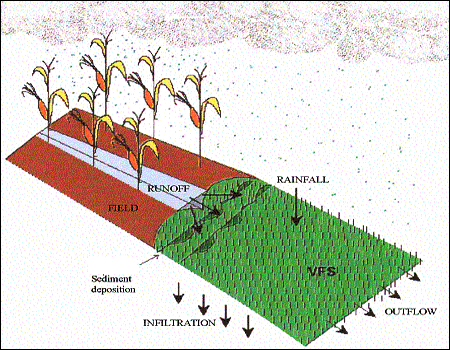Development of a Computer Model to Design Vegetative Filter Strips as a Best Management Practice to Total Maximum Daily Loads to Reduce Contaminant Transport by Runoff from Disturbed Lands
Participants: Rafael Muñoz-Carpena (UF), John Parsons (North Carolina State University - Raleigh)
Project Summary
This project was conducted within regional project CSREES S-1004. The model and additional information can be found at the VFSMOD-W site.
VFSMOD-W is a complete design-oriented computer modeling system (VFSMOD-W). The MS-Windows32 graphical user interface (GUI) integrates the numerical model VFSMOD, a utility to generate source (upslope) disturbed area inputs for the model based on readily available NRCS site characteristics (UH), and uncertainty, analysis of sensitivity and design menu-driven components.

Typical components in VFS filtering of surface runoff.
VFSMOD, the core of the modeling system, is a computer simulation model created to study hydrology and sediment transport through vegetative filter strips (VFS). The model comprises the following:
- a finite element solution is done for the overland flow equations for the strip
- infiltration within the strip is computed using the Green-Ampt method for unsteady rainfall
- sediment deposition and filtration is modeled using an implementation of the University of Kentucky grass filtration model
This model formulation effectively handles complex sets of inputs similar to those found in natural events. The improvements of this combined model over previous models are the inclusion of:
- state of the art description of flow through the filter
- changes in flow derived from sediment deposition
- physically based time dependent soil water infiltration
- handling of complex storm pattern and intensity
- varying surface conditions (slope and vegetation) along the filter
The model is targeted at studying VFS performance on an event by event basis. VFSMOD, when combined with the upslope source area input preparation utility (UH), becomes a powerful and objective VFS design tool. Although the model was originally developed as research tool, VFSMOD-W can now be used by planners and regulators to design optimal filter strips for specific scenarios, and to determine relative effectiveness of existing VFS.
The design objective implemented in VFSMOD-W is to find optimal constructive characteristics (length, slope, vegetation) of a VFS to reduce the outflow of sediment from a given disturbed area (soil, crop, area, management practices, design storm with desired return period) to achieve a certain reduction in % sediment (i.e., that for TMDLs). In the MS-Windows VFSMOD-W modeling system, versions 2.x and up, the design task is automated. The projects for each combination of design inputs are automatically created within the program GUI after the user selects a range on the desired parameters. This new version also automatically produces combined analysis output tables. Additionally, the program provides two powerful tools. Once the optimal design parameters are selected an uncertainty analysis can be conducted using the graphical tools provided. The objective of this analysis is to identify the level of confidence that the adopted design has against the uncertainties present when selecting the model inputs. Finally a sensitivity analysis procedure is included in the GUI to identify the parameters to which the model is more sensitive for a given scenario, thus allowing the user to economize effort by focusing on better identifying just the sensitive parameters.
Documentation for the model is available in several forms (web, printable .pdf documents, and online program help). This version of the model uses inputs that are easily obtainable from tables and other sources contained in the manual.
The following slide presentation gives details on a design application of the model about this ongoing project (requires Adobe Reader to view .pdf documents; advance presentation using Page Down/Up keys; exit with Escape key):
This page was last updated on July 13, 2019.